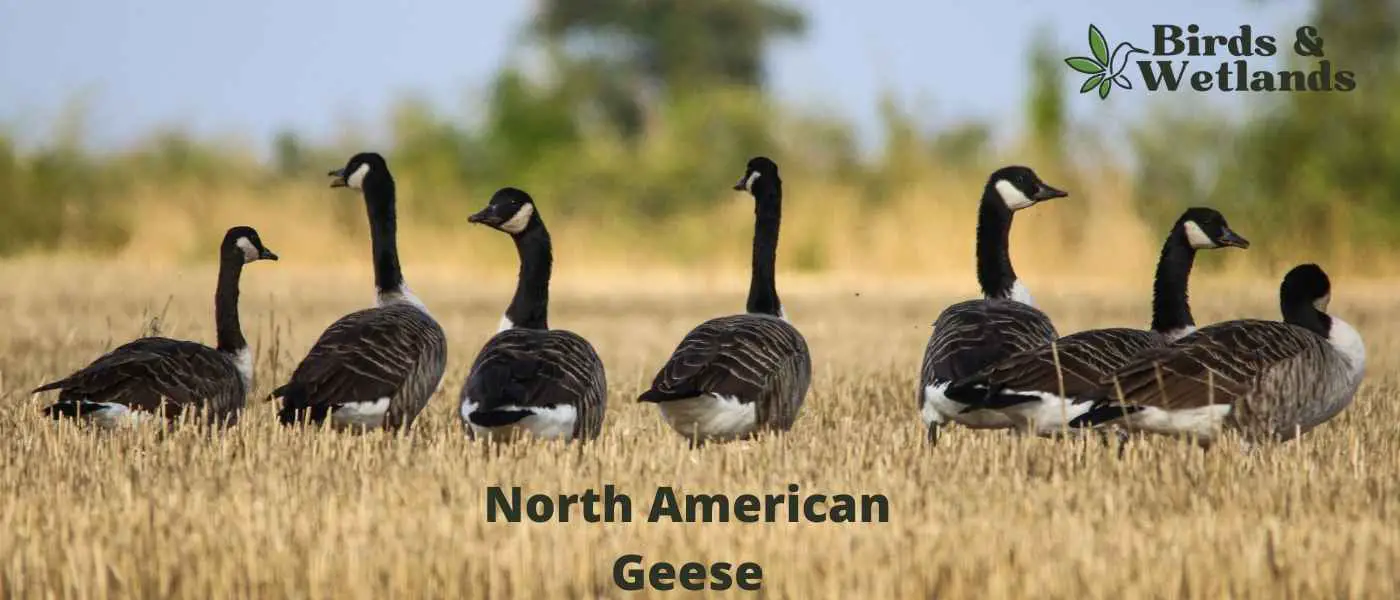There’s something special about watching a flock of geese fly overhead. These beautiful birds are a common sight in North America, and many people enjoy observing them during their migration seasons. If you’re interested in learning more about these fascinating creatures, keep reading!
In this guide, we will provide a guide to the geese species in America, including information on their physical characteristics (want to know the difference between a goose and a swan?), behavior (yes, Geese can Bite Humans), their diet (no don’t feed geese bread!) and more! However, some breeds of geese make great pets but geese are not great at keeping foxes away.
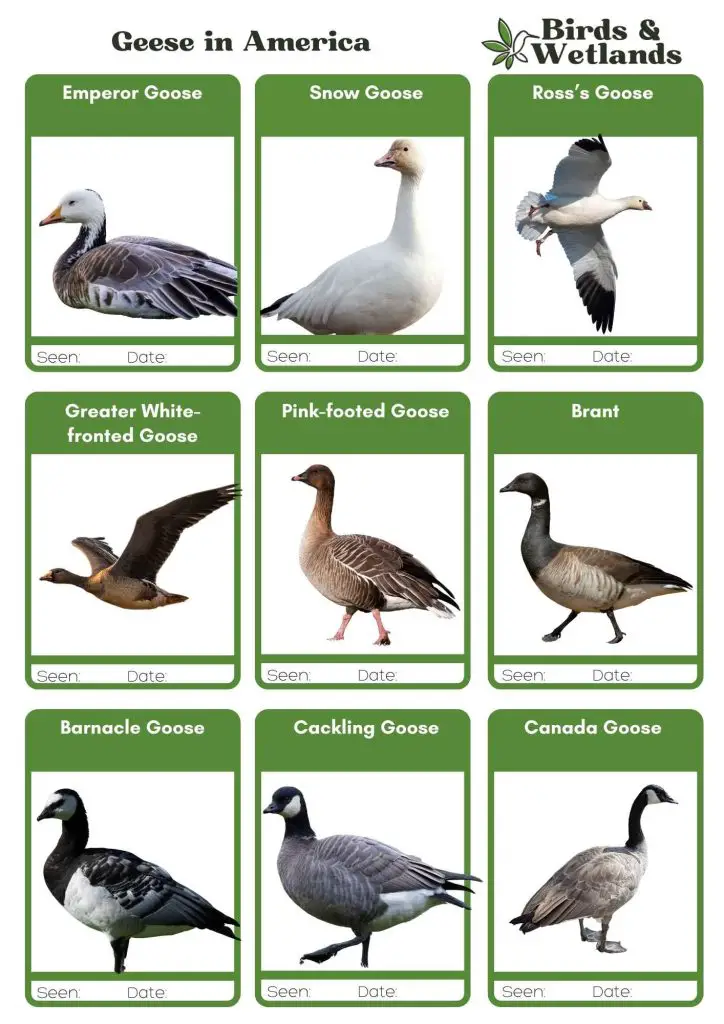
What Are North American Goose Species?
There are nine different goose breeds in North America:
- Emperor Goose
- Snow Goose
- Ross’s Goose
- Greater White-fronted Goose
- Pink-footed Goose
- Brant (Brent Geese)
- Barnacle Goose
- Cackling Goose
- Canada Goose
Rarely spotted geese found in America include accidental sitings of Graylag Goose, Lesser White-fronted Goose, Taiga Bean-Goose, Tundra Bean-Goose, Hawaiian Goose, Orinoco Goose and Egyptian Goose.
All of these birds share some common physical traits: they have long necks, webbed feet, and curved bills. They are also all excellent swimmers and flyers. However, there are some key differences between the species that you should be aware of.
Emperor Goose
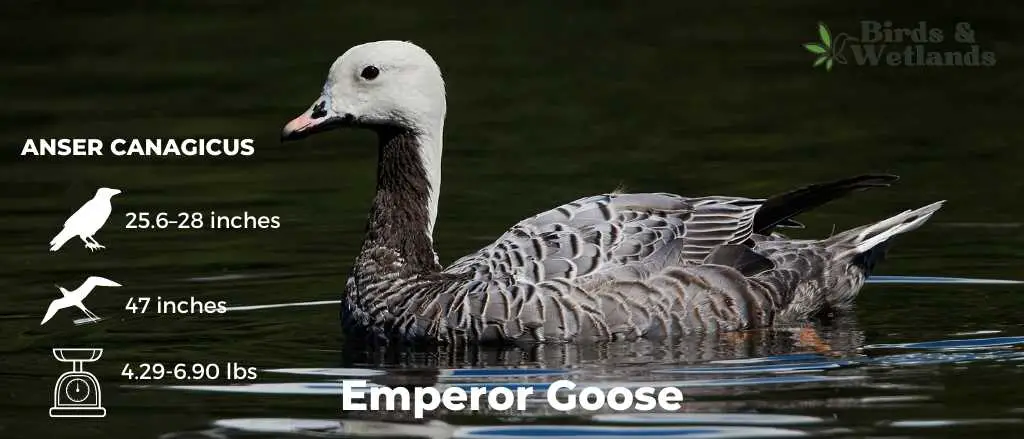
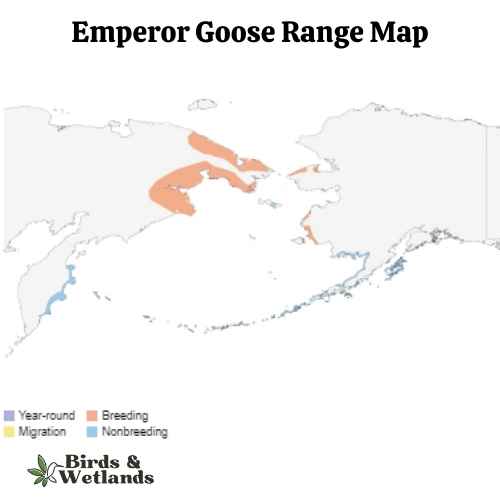
Listen:
Scientific Name: Anser canagicus
Length: 26–28 inches
Wingspan: 47 in
Weight: 4.29 lb
The Emperor Goose, also known as the beach goose or the painted goose, is one of the rarest geese in North America, and one that every birdwatcher hopes to see. This small and stocky goose is only found in Alaska. They are large birds with a wingspan of up to 4 feet and feed on the small plants in the mud at the edges of lakes and rivers, as well as roots and seeds.
The plumage is overall silvery gray, with a black and white margins making it look scaled. With a white head (which can become rust colored in the summer months), it has a black throat and its bill is small and pinkk, and the legs are orange. The sexes are similar, but juveniles have a duller plumage being gray all over.
Emperor geese need large tracts of land with patchy vegetation, water, and ample food to survive. Emperor geese use their bills to catch fish (and occasionally small mammals) while swimming in the water or flying over it. They thrive in wetland habitats because they provide the birds with food and protection from predators such as bears and wolves.
Female emperor geese lay 3-8 eggs per season in a nest made from grasses and plant material. She does the majority of incubation of the eggs, which take about 30 days to hatch.
Snow Goose
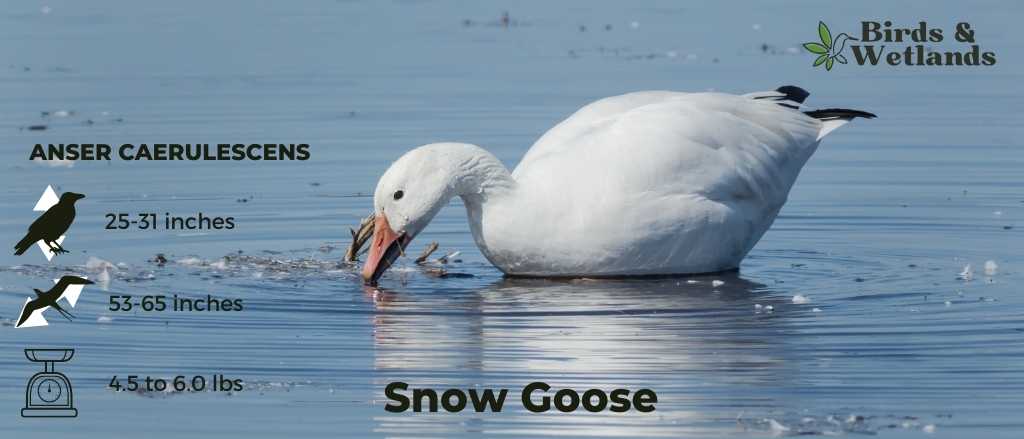
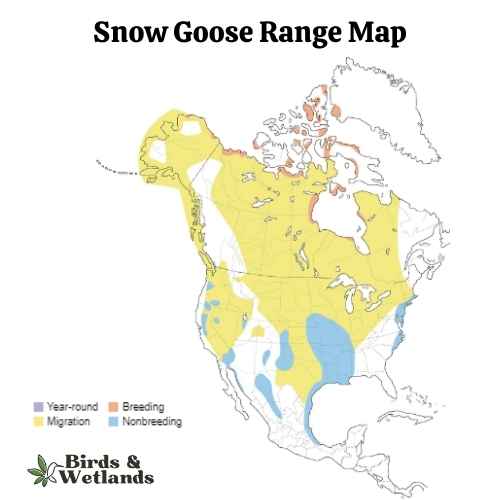
Snow Goose Sound
Scientific Name: Anser caerulescens
Length: 25 to 31 in
Wingspan: 53 to 65 in
Weight: 4.5 to 6.0
The Snow Goose is a large species of waterfowl known for its vibrant white plumage and significant migratory flights.
Appearance: True to their name, Snow Geese are predominantly white with black wingtips. They also have a pink bill, pink legs and feet. A color morph, known as the “Blue Goose,” displays a bluish-gray body with a white head, but is considered the same species.
Diet: Snow Geese primarily feed on plant matter, such as grasses, sedges, and small grains. They can often be seen in large flocks foraging in fields and marshes, and during migration and winter, they can cause considerable damage to agricultural fields due to their feeding habits.
Reproduction: Snow Geese typically nest on the tundra, near water bodies. The female builds the nest and lays a clutch of about 3 to 5 eggs, which she incubates alone for approximately three weeks. Once hatched, the goslings can feed themselves but stay with their parents for protection until they can fly.
Ross’s Goose
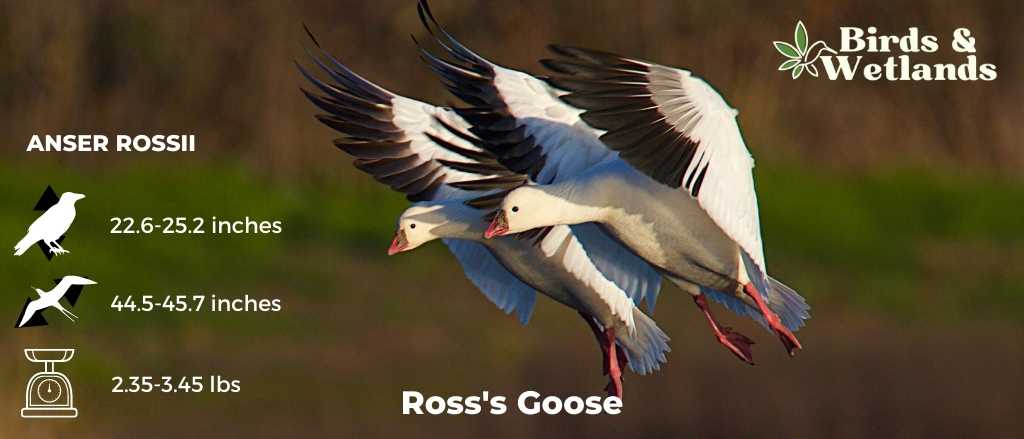
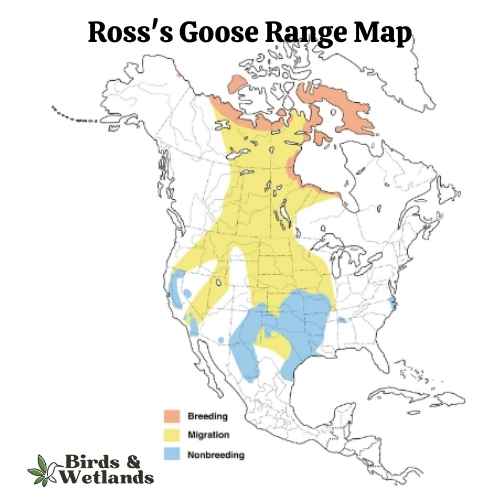
Listen
Scientific Name: Anser rossii
Length: 23.2-25.2
Wingspan: 44.5-45.7 in
Weight:42.3-55.3 oz
The Ross’s Goose is a small species of waterfowl often found in North America’s tundra and wetland habitats.
Appearance: Known for its compact size, the Ross’s Goose is mostly white with black wingtips. It features a short, stubby bill and a rounded head. One key identifying feature is the blueish gray base of its bill, which has a warty structure during the breeding season.
Diet: This goose feeds mainly on vegetation, including seeds, leaves, and roots of grasses and sedges. During winter and migration, they also consume grains and seeds from agricultural fields.
Reproduction: The Ross’s Goose nests on the ground, often in colonies. The female lays a clutch of 2 to 5 eggs which she incubates for around three weeks. The young geese, known as goslings, are precocial – they can walk, swim, and feed themselves shortly after hatching, although they stay with their parents until they learn to fly.
Greater White-fronted Goose
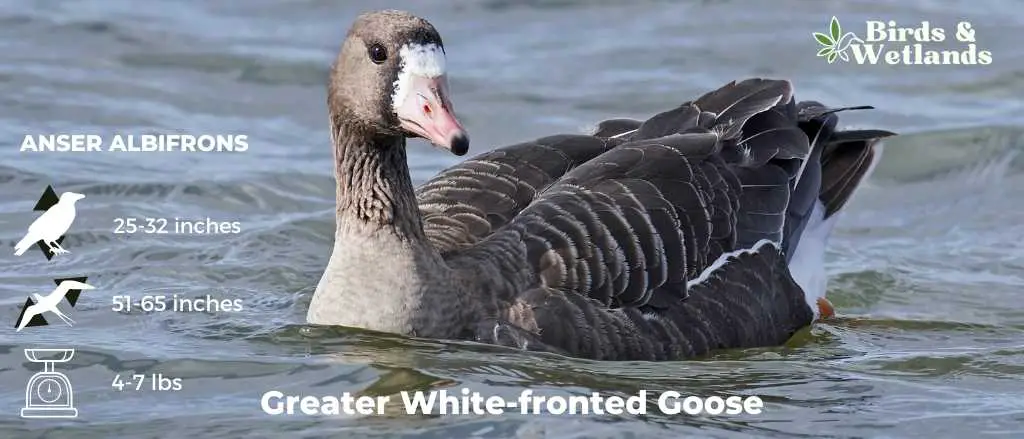
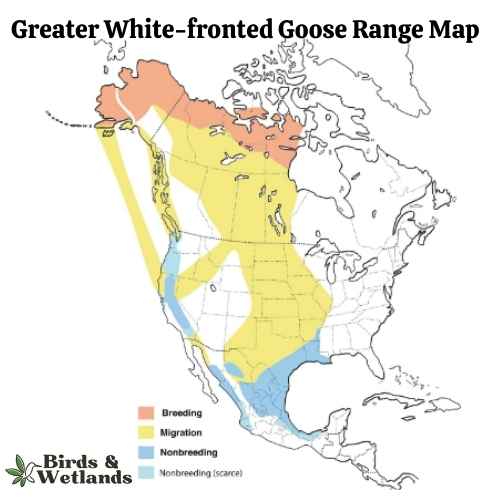
Listen
Scientific Name: Anser albifrons
Length: 25 to 31 in
Wingspan: 53 to 66 in
Weight: 3.3 to 6.6
The Greater White-fronted Goose is a medium to large waterfowl species, widely distributed across the Northern Hemisphere, particularly in North America.
Appearance: As the name suggests, these geese display a prominent white patch at the base of their bill. Their bodies are gray-brown, and their breasts are often marked with dark blotches. They possess a pinkish bill and orange legs and feet.
Diet: The Greater White-fronted Goose is a herbivore and feeds mainly on plant material. Its diet consists of grasses, sedges, grains, and berries. When wintering, these geese can often be found in agricultural fields, feasting on leftover grains and crops.
Reproduction: This species nests on the ground, often in areas with good visibility such as slopes or ridges. The female lays a clutch of 4 to 5 eggs, which she incubates for nearly a month. Once hatched, the young ones are taken care of by both parents until they are able to fly.
Pink-footed Goose (Anser brachyrhynchus)
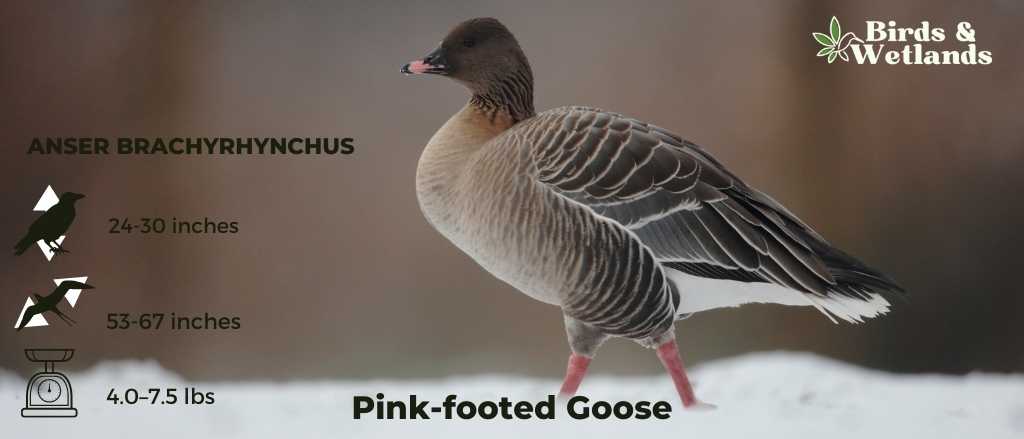
- Scientific Name: Anser brachyrhynchus
- Height: 60–75 cm (24–30 in)
- Wingspan: 135–170 cm (53–67 in)
- Weight: 1.8–3.4 kg (4.0–7.5 lb)
This is a rare visitor to North Eastern US, but becoming increasingly more common as it migrates with other geese species. It is a small goose which breeds in the Artic.
Pink-footed Goose Description
The Pink-footed Goose is a medium-sized goose with a pinkish bill and legs, as well as a white belly. It has a white head and neck with a black stripe running down its back and a black tail. The body is white except for a black breast, belly, and vent. The bill is yellow and red, with yellow on top and red on the bottom. The legs are pink.
Listen to Pink-footed Goose
Pink-footed Goose Habitat & Range
It’s a migratory goose that breeds in Iceland, Greenland, and Scandinavia. It winters on the coasts of North America and Europe. They are also known for gathering in large flocks to feed or roost together during migration.
In winter, they migrate south to warmer climates in Europe or Africa. The population is large enough that they can survive in areas where there is no natural water source for them to nest in—they simply dig holes in dry grassland instead.
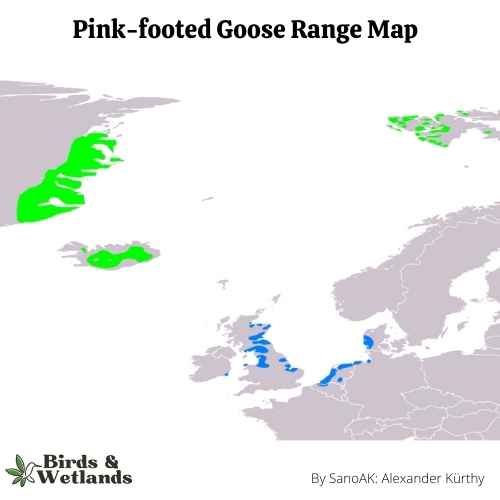
Pink-footed Goose Diet
Pink-footed geese feed on aquatic plants, including algae and tubers such as sedges and grasses; they also eat small fish and invertebrates such as snails or worms when they can find them.
Pink-footed Goose Nesting
They breed on the Arctic tundra near ponds or lakes that have open water in summer. Their nests are made formed in rocky crags. They lay 3-6 eggs per clutch and both parents incubate them for about 25 days.
Brant
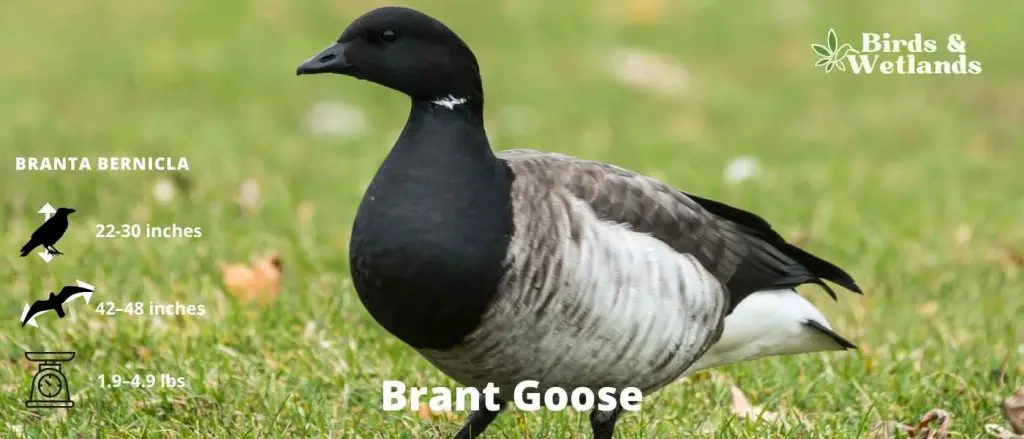
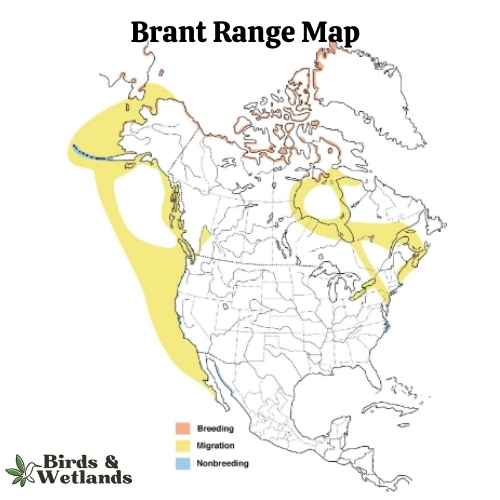
Listen
Scientific Name: Branta bernicla
Length: 22–26 in
Wingspan: 42–48 in
Weight: 1.9–4.9 lb
The Brant is a compact species of goose that is known for its striking appearance and interesting migratory patterns.
Appearance: The Brant is recognized for its dark, sooty color with a white crescent on the neck. The body is mostly black to dark gray, contrasting with the lighter underparts. Its small size, as compared to other geese, and short, stubby bill are other distinct features.
Diet: The Brant’s diet primarily consists of aquatic plants, especially eelgrass and sea lettuce. During the breeding season, they may also feed on grasses, sedges, and insects.
Reproduction: Brants typically breed in the high Arctic tundra. The female lays a clutch of 3 to 5 eggs in a ground nest, which she incubates for about a month.
Notably, Brants make an impressive long-distance migration every year. They spend their winters along both the east and west coasts of the United States and travel to the Arctic regions of Canada, Alaska, and even Russia to breed.
Barnacle Goose (Branta leucopsis)
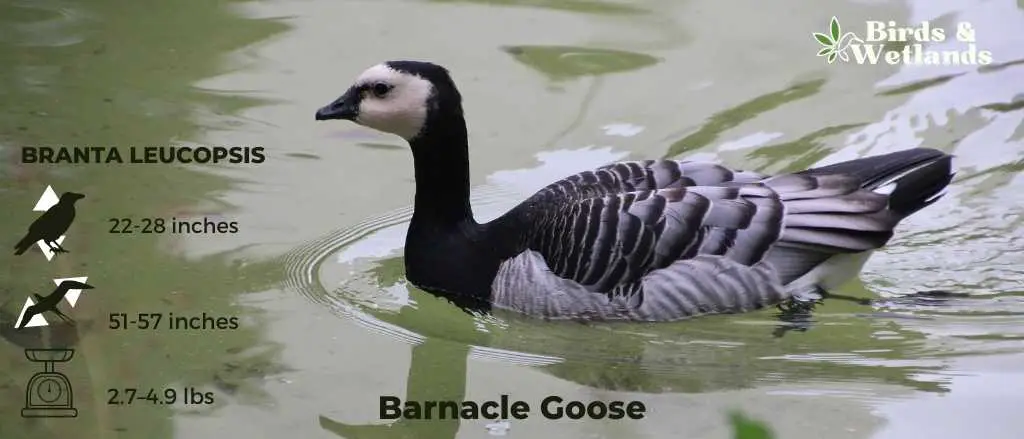
Rare in North America and when spotted its usually within a flock of Canada Geese.
- Scientific Name: Branta leucopsis
- Height: 55–70 cm (22–28 in)
- Wingspan: 130–145 cm (51–57 in)
- Weight: 1.21–2.23 kg (2.7–4.9 lb)
Barnacle Goose Description
The barnacle goose is a small goose with a white body and black wings, a black neck, with a white face and black bill. Its crown, eye line and legs are black.
Listen to Barnacle Goose
Barnacle Goose Habitat & Range
Barnacle geese are migratory geese that are native to the Arctic and northern Europe. They spend winters in southern Europe, Africa, India, and Australia. They breed in Iceland, Greenland, Northern Scandinavia, and Canada.
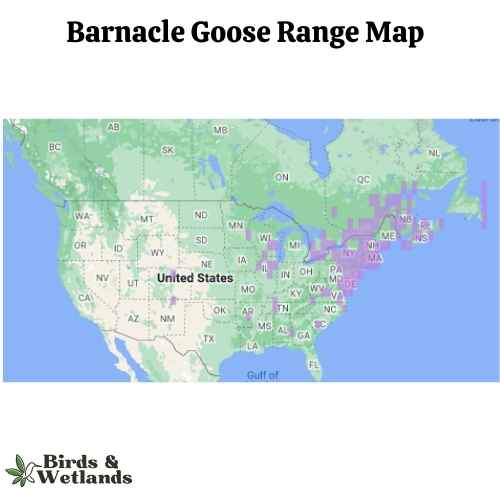
Barnacle Goose Diet
Barnacle Geese feed primarily on grasses, leaves, and other aquatic plants, grains, and algae during their breeding season but also consume insects during migration periods when food may be scarce.
Barnacle Goose Nesting
The Barnacle Goose lays 4-6 eggs in a nest lined with down but on the rock edge. The young Barnacle Goslings have to undergo significant challenges making their way from cliff edges to the water below a few hours after hatching.
Cackling Goose
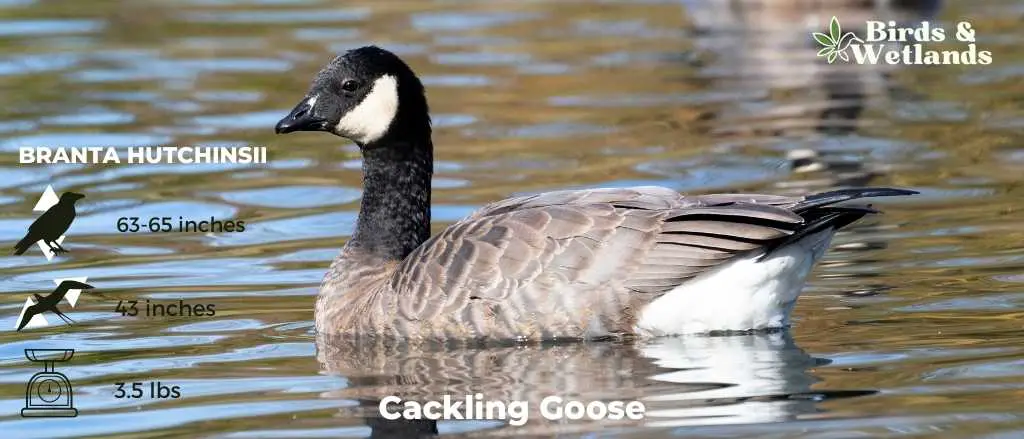
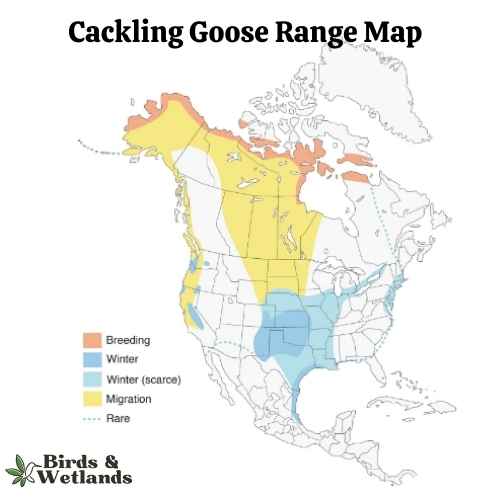
Listen
Scientific Name: Branta hutchinsii
Length: 24.8–25.6 in
Wingspan: 43-45.7 in
Weight:3.5 lbs
Cackling Geese are particularly known for their high-pitched, cackling calls, which is the source of their name. Despite their small size, these geese are renowned long-distance migrants, with some populations traveling thousands of miles between breeding and wintering grounds.
Appearance: With a similar color pattern to the larger Canada Goose, the Cackling Goose features a black head and neck, white chinstrap, light tan to cream chest, and brownish-grey body. One defining characteristic is its noticeably smaller size and stubbier neck compared to its larger counterparts.
Diet: Like many geese, the Cackling Goose’s diet mainly consists of plant matter. This includes grasses, seeds, and aquatic vegetation. They are often seen grazing on land or dabbling in shallow water.
Reproduction: Cackling Geese usually nest on the ground in elevated areas near water bodies, such as riverbanks or lakeshores. The female lays a clutch of 2 to 8 eggs and is responsible for incubation, while the male stands guard nearby. Incubation lasts for about a month.
Canada Goose
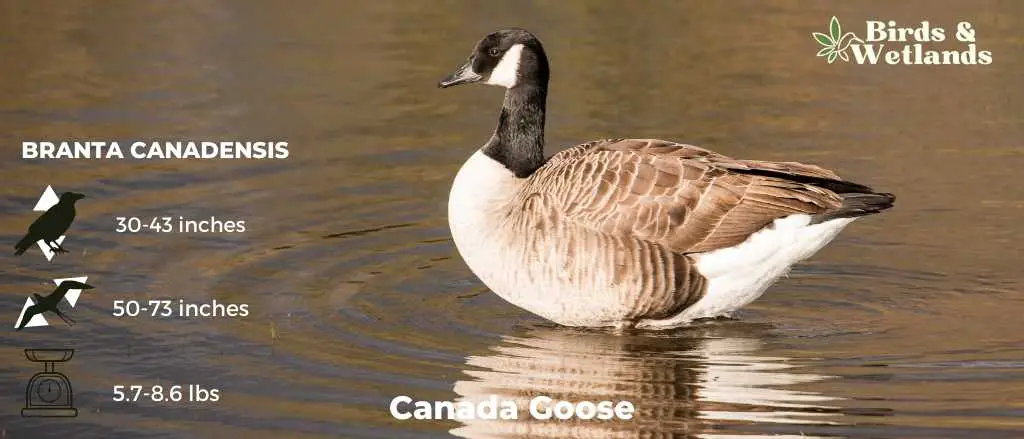
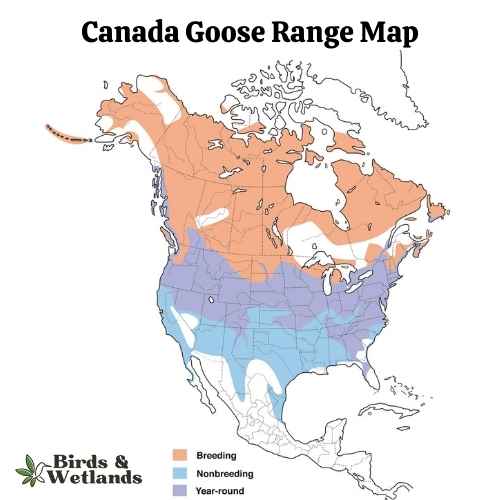
Canada Goose Sound
Scientific Name: Branta canadensis
Length: 30 to 43 in
Wingspan: 50–73 in
Weight: 5.7–14.3 lb
The Canada Goose is a large, well-known species of waterfowl noted for its distinctive appearance, familiar “honk,” and migratory behavior.
Appearance: Both male and female Canada Geese have a similar appearance, featuring a black head and neck with distinctive white patches on the cheeks and chin. The body is primarily brown with a lighter, often white, underbelly.
Diet: Canada Geese primarily feed on plant matter, including grasses, aquatic vegetation, and grains. They can often be seen grazing in parks, lawns, and fields, as well as dabbling in water bodies.
Reproduction: Canada Geese typically nest on the ground near water bodies, often on islands or other isolated areas to avoid predators. The female lays a clutch of about 4 to 6 eggs, which she incubates alone for around a month.
A sub species of the Canada goose is the Giant Canada Goose.
What kind of geese are in North America?
Most of the geese in America are direct descents of the original goose, the greylag goose. From that you will get many different species from a dusky canada goose, cackling canada goose, a snow goose with a blue morph colour, to a snow goose notable by its pink legs, or the Greater white fronted goose notable for its dark brown head.
From white geese to grey geese and the mixture in between can be found, and there has even been an occasional spotting of a red breasted goose. The swan goose duck species are all part of the waterfowl family.
How many types of geese are there in North America?
There are 9 different species of geese in America, though some of these can be broken down into further species, and also there are 7 ‘accidental’ geese found here, who are not native but have been spotted often in flocks of other geese.
There are seven native geese species in the US.
What is the most common geese in North America?
The most common is the canada goose which is very prevalent across the US, and can be found on parks, golf courses and even larger gardens. The giant canada goose is the largest wild goose in the US and it was thought it was the same species as the cackling goose, but recent studies have shown them to be separate species.
Accidental Geese Species in America
The following geese are spotted on occassion in America, but these are rare and ‘accidental’.
- Graylag Goose
- Lesser White-fronted Goose
- Taiga Bean-Goose
- Tundra Bean-Goose
- Hawaiian Goose
- Orinoco Goose
- Egyptian Goose
Graylag Goose (Anser Anser)
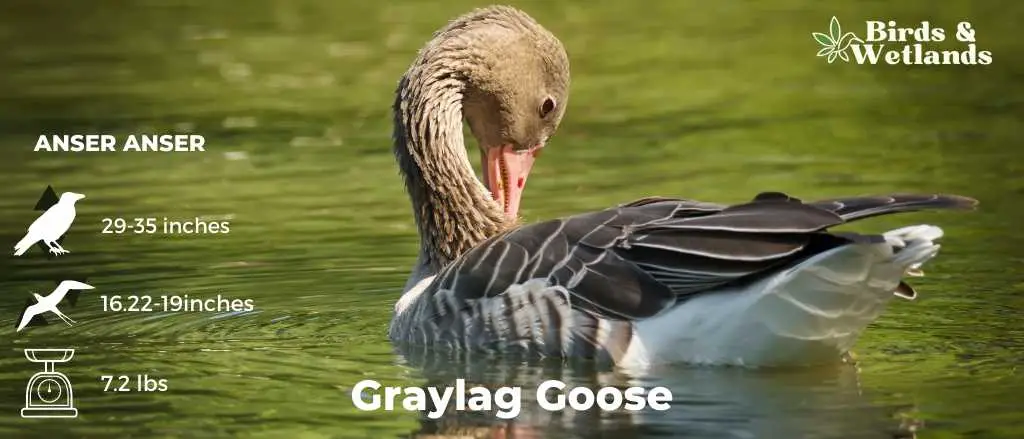
The Graylag goose is a species of goose that is native to Europe, Africa, and Asia. It has a grayish-brown plumage, a dark grayish brown body with a white neckband, crown, and rump, and its legs are yellow-orange. The head of the bird is black with a white ring around its neck. It has a light brown breast and belly with dark brown wings, tail, and bill.
- Scientific Name: Anser anser
- Length: 74 – 91 centimetres
- Wingspan: 41.2 – 48 centimetres (16+1⁄4 to 19 in)
- Weight: 3.3 kilograms
Graylag Goose Description
In the wild, most Graylag geese inhabit arid landscapes such as grasslands or open fields near water bodies where they can find food such as grains, grasses, seeds, or berries; they also eat aquatic plants like water lilies. The Graylag goose lives in large groups on land or in water.
Graylag Goose Sound
Graylag Goose Habitat & Range
It winters southwards to the Mediterranean region and throughout Europe, including Great Britain. In England and Wales, it is often known as the barnacle goose due to its habit of feeding on barnacles attached to rocks in coastal areas
During winter months when food is more plentiful they congregate in large flocks near water bodies such as rivers or lakes where they forage for seeds along river banks or floating ice sheets which offer protection against predators such as wolves and lynx.
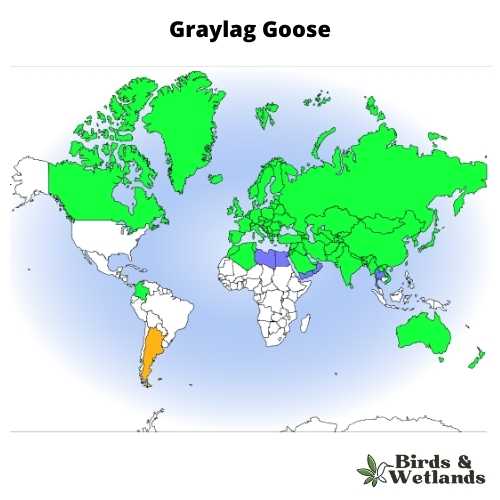
Graylag Goose Diet
They are very social birds, often forming large flocks where there is enough food for everyone to eat together without causing too much competition for resources like food or water sources. This means that it is not uncommon for there to be hundreds of thousands of these birds together at once!
Graylag Goose Nesting
The Graylag goose breeds mainly in the UK but also nests in arctic tundra of northern Europe and Asia. They nest in holes in trees or on the ground.
The female lays an average of 7 eggs per clutch and incubates them for 28 days. The young will grow quickly after they hatch and will be able to fly within 40 days of birth!
Lesser White-fronted Goose (Anser erythropus)
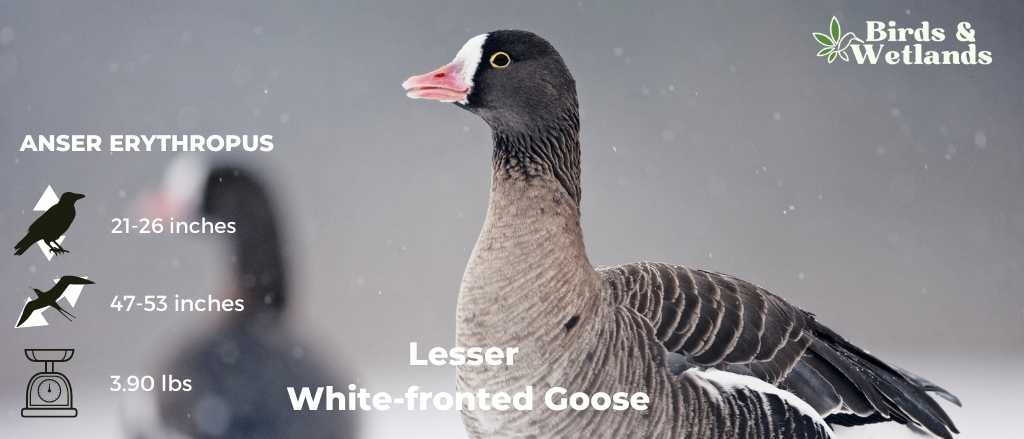
Listen to Lesser White-fronted Goose
Lesser White-fronted Geese are medium-sized geese with a black head and neck, a white breast and belly, and a brown back. They have a white patch at the base of the bill that extends over their face. They also have a red wattle at the base of their bill. The sexes are similar in appearance.
- Scientific Name: Anser erythropus
- Height: 53–66 cm (21–26 in)
- Wingspan: (120–135 cm 47–53 in)
- Weight: 1.8 kg
Lesser White-fronted Goose Description
The scientific name comes from anser, the Latin for “goose”, and erythropus, “red-footed”, derived from the old Greek eruthros “red” and pous “foot”.
Lesser White-fronted Goose Sound
Lesser White-fronted Goose Habitat & Range
This species prefers to live near fresh water marshes with tall grasses where they can feed on reeds and other aquatic plants. They are migratory birds that will travel over great distances during their annual migration journey to find food and shelter for the winter months when temperatures drop below freezing point (Fahrenheit) at night time temperatures throughout most parts of the world where they reside during this time period each year.
They live in Europe and Asia as well as parts of Africa. They migrate south for the winter to warmer climates in Africa, India, Pakistan, and southern China.
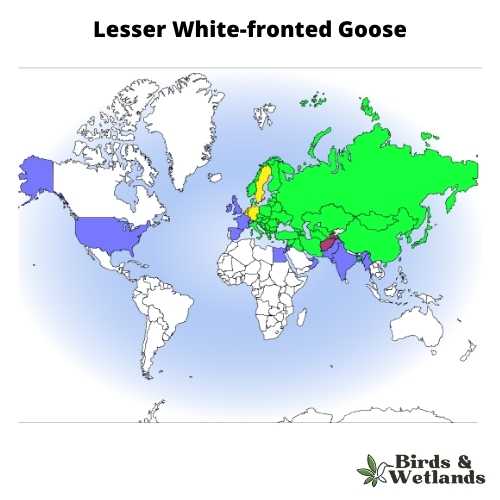
Lesser White-fronted Goose Diet
Lesser White-fronted Geese eat grass and aquatic plants like cattails and bulrushes. They also eat insects such as beetles, flies, moths, spiders, snails, and worms when they can find them during migration or while visiting wetlands during the breeding season or wintering grounds.
Lesser White-fronted Goose Nesting
They nest on the ground in the Arctic tundra in Siberia or Greenland. The current population is estimated to be around 1 million birds worldwide, according to The International Union for Conservation of Nature (IUCN).
Taiga Bean-Goose (Anser fabalis)
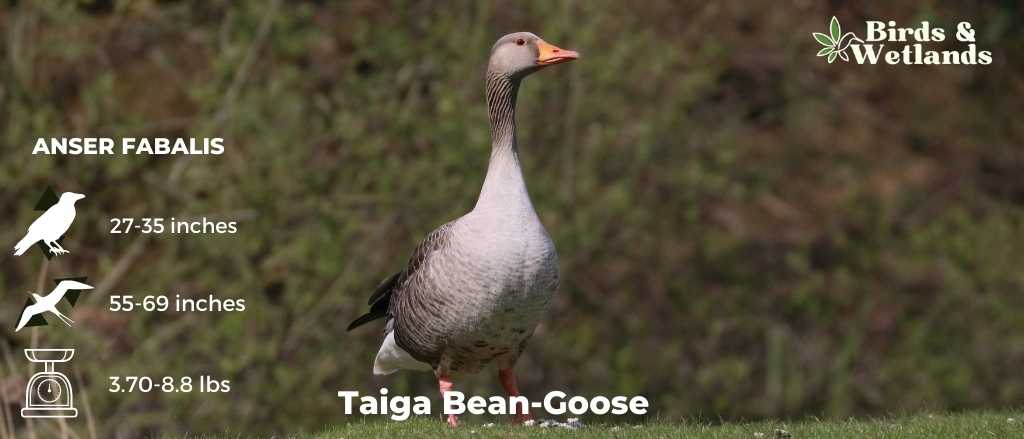
The Taiga Bean-goose is one of the rarest birds in North America. It was first observed in 1804, and it has been spotted only a handful of times since then. It is also known as the Bean Goose, Jack Snipe Goose, or Buff-breasted Goose.
- Scientific Name: Anser fabalis
- Height: 68 to 90 cm (27–35 in)
- Wingspan: 140 to 174 cm (55–69 in)
- Weight: 1.7–4 kg (3.7–8.8 lb)
Taiga Bean-Goose Description
It has black plumage on its back and brown plumage on its chest, with white on its face and neck. It also has a bright red bill and legs, which help to distinguish it from other species of goose that have similar markings but different colors on their legs or bills.
Taiga Bean-Goose Sound
Taiga Bean-Goose Habitat & Range
The Taiga Bean-Goose breeds in the taiga of northern Russia and winters in Southeast Asia, China, and Japan. It is a migratory bird that breeds in the taiga of northern Europe and Asia, with the majority of its population wintering in southeast Europe.
The Taiga Bean-goose can be found in northern Canada and Alaska during the summer months. However, they migrate southward during the winter months so they can remain warm enough to survive in these cold climates. This bird prefers to live in remote areas such as bogs or wetlands where there aren’t many humans around so that it doesn’t have to compete for food with people or other animals such as bears or wolves (which might prey upon them).
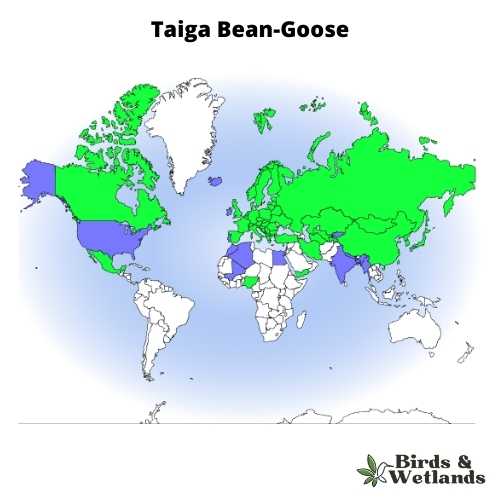
Taiga Bean-Goose Diet
The Taiga Bean-Goose feeds on plants like sedges and grass, which they find by digging through snow or using their bill to probe beneath it. Their diet also includes insects like grasshoppers, snails, and worms. These birds have an average lifespan of 20 years, but some have been known to live as long as 40 years!
This bird prefers cold climates—its range includes tundra and taiga forests that are above the tree line in the northern hemisphere. It breeds in these areas and migrates south during winter.
Taiga Bean-Goose Nesting
The Taiga Bean Goose is a protected species in Canada as well as many other countries throughout Europe and Asia. It’s one of the most common species of geese found throughout these areas, so it’s very important that we continue protecting them so that they don’t become extinct!
Tundra Bean-Goose (Anser serrirostris)
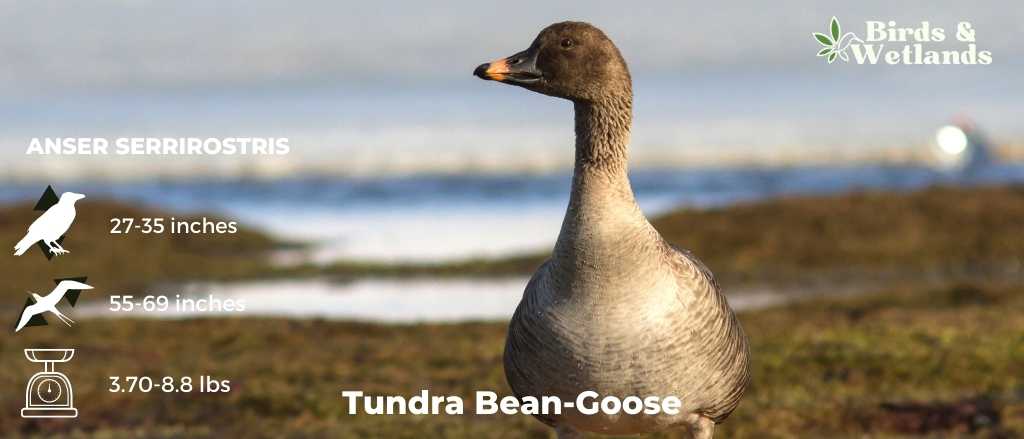
The Tundra Bean-goose is a beautiful, unique bird breed in northern Siberia. This bird is also called the Pink-footed Goose, despite having feet that are mostly black. This bird is also called the Pink-footed Goose, despite having feet that are mostly black.
- Scientific Name: Anser serrirostris
- Height: 68 to 90 cm (27–35 in)
- Wingspan: 140 to 174 cm (55–69 in)
- Weight: 1.7–4 kg (3.7–8.8 lb)
Tundra Bean-Goose Description
The Tundra Bean-Goose is a medium-sized goose with a black head and neck, white cheeks, and a creamy-white breast. It has black wings with white primary feathers on the inner edges. Its tail is black with cream-colored tips on the outer feathers. The legs are pinkish-brown, and its bill is bright red.
While this bird spends most of its time foraging for food, it will often fly into the air at speeds of up to 60 miles per hour when disturbed by humans or predators. It’s also one of the fastest birds in the world.
Tundra Bean-Goose Sound
Tundra Bean-Goose Habitat & Range
The Tundra Bean Goose breeds in North America, Greenland, and Iceland. They migrate southwards in winter to Europe, Africa, South Asia, and Australia. The populations from Canada and Alaska migrate south through the Rocky Mountains into California, Mexico, and Central America.
While once common throughout their range, the population has declined dramatically due to hunting and habitat destruction. The species is currently listed as endangered under the Endangered Species Act (ESA) if climate change continues to impact its habitat.
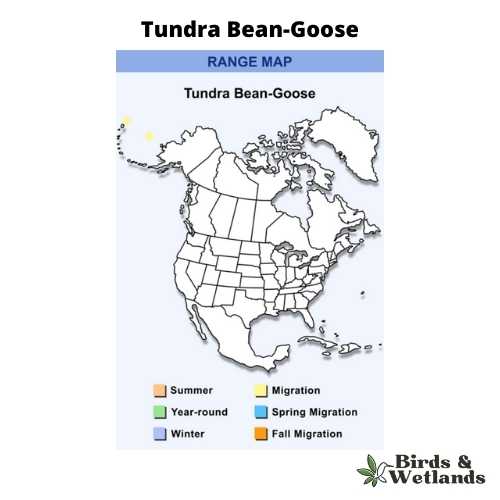
Tundra Bean-Goose Diet
They eat grass and sedges, which they find by probing the ground with their bills. Their diet also includes insects such as beetles or flies and larvae, grasses, and sedges found in the wetland areas where they live. They are monogamous and form lifelong bonds with their mates.
Tundra Bean-Goose Nesting
This bird uses open grassy areas for breeding but will also nest on tundra and coastal areas where there are no trees or shrubs nearby such as Arctic tundra (where it can be found during summer months) or glaciated regions such as Greenland (where it can be seen during winter).
Hawaiian Goose (Branta sandvicensis)
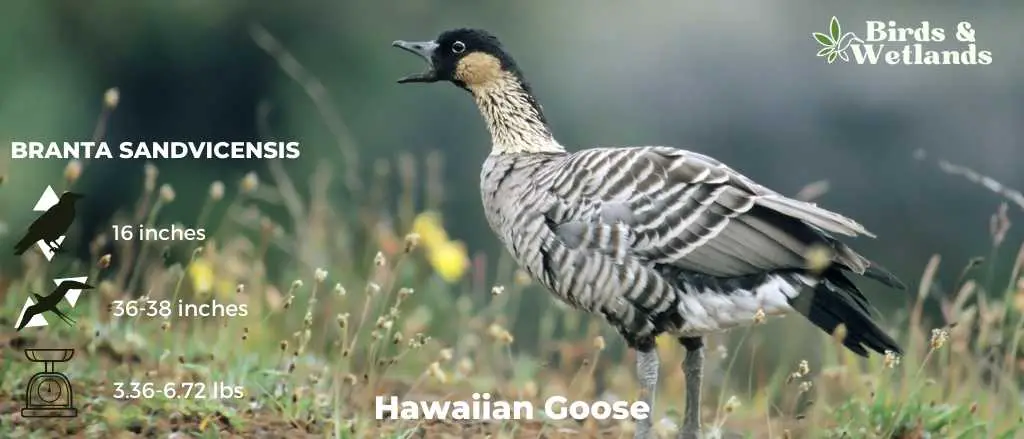
The Hawaiian Goose is a unique bird that lives in Hawaii, and it’s one of the most sought-after species by birdwatchers. They can fly up to 55 miles per hour (88 kilometers per hour).
- Scientific Name: Branta sandvicensis
- Height: 41 cm (16 in)
- Wingspan: 36-38 inches
- Weight: Males: 1.695–3.05 kg (3.74–6.72 lb) / Female: 1.525–2.56 kg (3.36–5.64 lb)
Hawaiian Goose Description
The Hawaiian Goose has a reddish-brown hue on its head and neck, with white flanks and belly. Its wings are black with white outer edges, and its legs are long and pink. The bill of the Hawaiian goose is light grey, with a white tip on the upper mandible.
Hawaiian Goose Sound
Listen to Hawaiian Goose
Hawaiian Goose Habitat & Range
The habitat for the Hawaiian Goose includes grasslands and wetlands, coastal dunes, lava plains, and related anthropogenic habitats such as pasture as well as open clearings in forests near bodies of water on the Hawaiian Islands of Kauai, Oahu, Molokai, Maui, and Hawaii.
This species tends to live near bodies of water because it relies on them for food and survival.
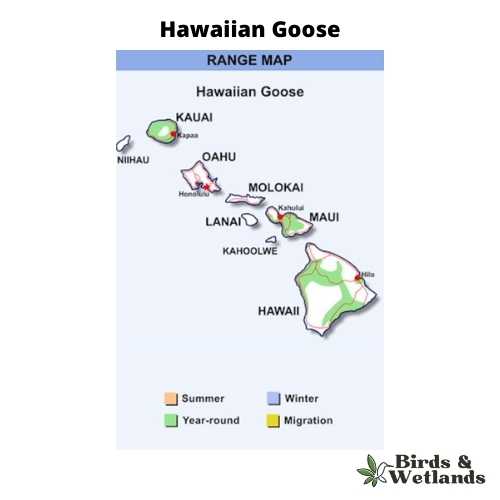
Hawaiian Goose Diet
The Hawaiian goose prefers grasses and other plants for feeding purposes. They also eat small insects such as ants, termites, beetles etc., when available in abundance during certain seasons like summer months. They have been seen to form large flocks when there is plenty of food available, but they will split into smaller groups when conditions are not favorable for feeding.
Hawaiian Goose Nesting
These geese usually live in pairs or small groups, but they may gather together with other species of birds during mating season or to care for their offspring. They build their nests on the ground near water sources like ponds or streams.
The Hawaiian Goose is endemic to Hawaii and has been endangered since 1967, according to the International Union for Conservation of Nature (IUCN). Its population was once around 100 birds in 1940 but has since dropped significantly due to habitat loss and the introduction of non-native species such as mongooses and rats into their natural habitat.
Orinoco Goose (Neochen jubata)
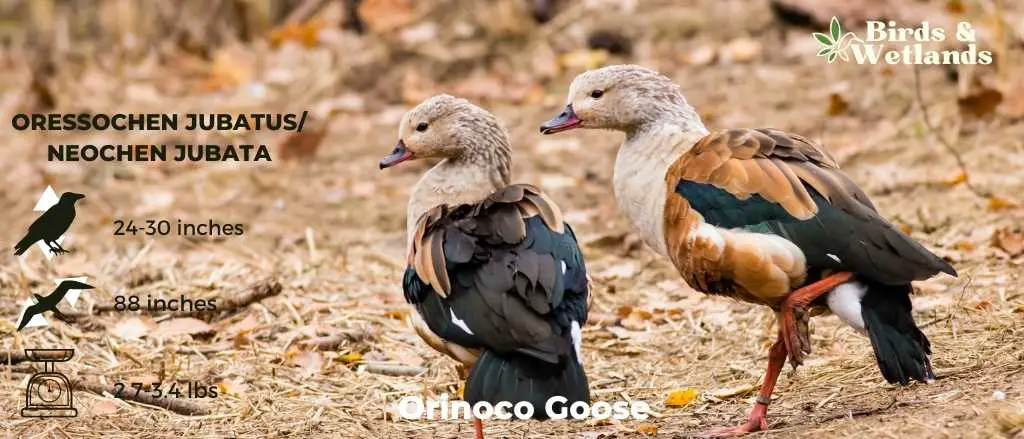
The Orinoco Goose is a migratory bird that can be found in the Caribbean region. It is the only goose species that nests in trees near water sources such as rivers or lakes, and it does so in large colonies. They are known as “tree geese” because they nest in tree cavities or on branches instead of on the ground like other birds do.
- Scientific Name: Neochen jubata
- Height: 61 to 76 cm (24 to 30 in)
- Wingspan: 88 inches
- Weight: Males: 3.4 pounds (1.54 kg) / Females: 2.7 pounds (1.22 kg)
Orinoco Goose Description
The Orinoco Goose is a large, long-necked goose that has a long, narrow bill with a black tip and pink base. The male Orinoco Goose has a dark chocolate brown head, neck, and breast with white cheeks and forecrown. The female is similar to the male but has a lighter brown head, neck, and breast with white cheeks.
Orinoco Goose Sound
Listen to Orinoco Goose
Orinoco Goose Habitat & Range
The Orinoco Goose is rarely seen outside of its natural habitat in South America. This habitat consists primarily of marshy areas near swamps, rivers and lakes.
They live in the marshes of South America, where it can be found in Venezuela, Colombia and Brazil. They are also found in Central America, but here they are not as common as they are in South America.
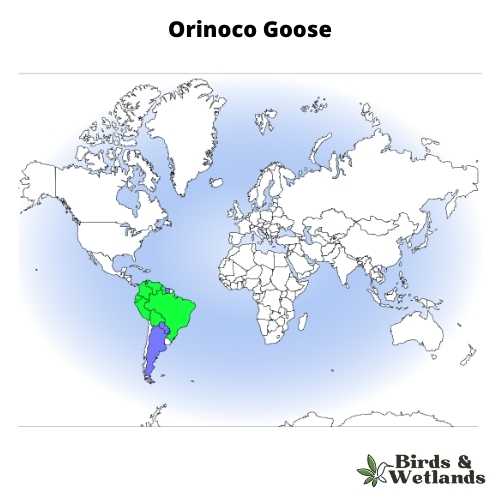
Orinoco Goose Diet
The diet of the Orinoco Goose consists mostly of aquatic plants such as water lilies and floating weeds but also includes seeds from sedges and cattails. They will also eat small insects if they happen to come across them while searching for food in shallow waters where these insects dwell during dry seasons.
Orinoco Goose Nesting
It is most common in Venezuela, Guyana, and Colombia; however, due to hunting for its meat and feathers, it has become increasingly rare. In fact, this species is classified as “Near Threatened” according to IUCN Red List criteria.
Egyptian Goose
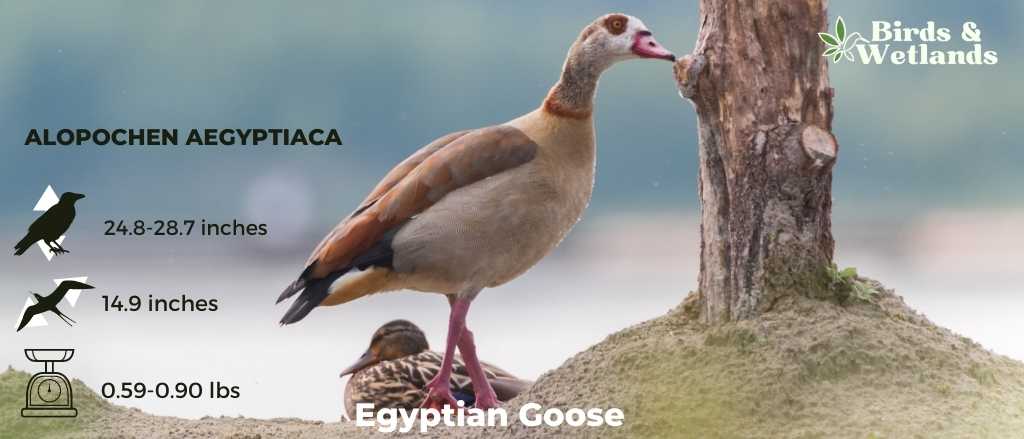
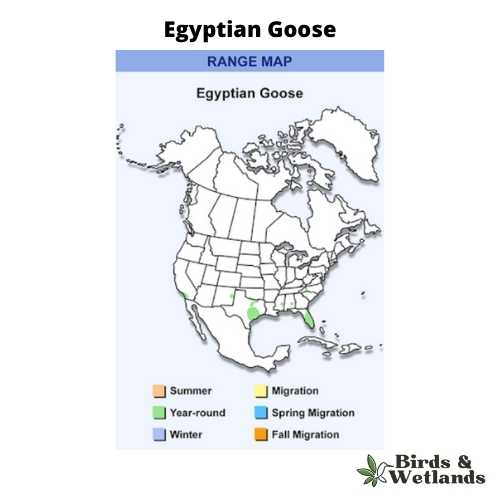
Listen
Scientific Name: Alopochen aegyptiaca
Length: 24.8 to 28.7 cm
Wingspan: 38 cm
Weight:1.5 to 2.3 kgs
The Egyptian Goose is a distinct waterfowl species celebrated for its unique coloration and adaptability to various environments.
Appearance: Egyptian Geese are quite striking, displaying a combination of brown, white, and grey feathers. They also have a chestnut patch around their eyes and on the chest, along with a distinctive dark brown ring around their lower neck. Their pink legs and feet and pinkish bill stand out against their body color.
Diet: The diet of the Egyptian Goose primarily consists of plant matter. They feed on grasses, seeds, leaves, and crops, and can often be seen grazing in fields and on the water’s edge.
Reproduction: Egyptian Geese typically make their nests in a variety of places including tree cavities, reed beds, and cliffs. The female lays a clutch of 5 to 12 eggs, which she incubates for about a month.
Originally native to Africa, the Egyptian Goose has established populations in parts of the United States, where it was introduced through the pet trade. Despite not being native, they have adapted well to American habitats, particularly in suburban and urban areas where they can often be seen in parks and on golf courses.
Geese Diet
If you have pet geese or even want to feed some wild geese, then follow our guides to what geese can and can’t eat, you can even find out Why Do Geese Eat Grass? It’s important if keeping geese to ensure they have a balanced diet and this includes ensuring your geese eat enough niacin.
- Can Geese Eat Bananas?
- Can Geese Eat Bread?
- Do Geese Eat Fish?
- Do Geese Eat Worms?
- Do Geese Eat Frogs?
- Do Geese Eat Bugs?
- Why Do Geese Eat Grass?
Geese Health & Behavior
If you are looking at wild geese, there are many things to remember. Goose droppings can be toxic, but geese don’t carry rabies but do have other pests like ticks. Geese can attack humans if you get to close and they can bite, with geese tongues have teeth like features and yes, geese do have ears!
Geese can be a pest or a nuisance and you may need to take actions to get rid of geese of your property and especially to keep geese off your dock. Geese can live a long time so its important to move them along if you don’t want them on your property. Scaring geese with sounds can help.
As waterfowl, generally, geese and ducks get along (however, geese and ducks cannot mate).Geese have webbed feet like ducks and geese will drool. However, geese may attack ducks and will attack other geese, like all wild animals to defend their nests, even attacking snakes and remember Geese can Eat Snakes.
Nesting Geese
Geese can lay eggs continually, but generally don’t unlike chickens, with goose eggs hatching in 27 days.. Goslings or baby geese stay with both parents for the season (often carried by their parents), and goslings learn to fly after a few weeks. Geese don’t generally abandon their eggs, unless they have been spooked.
Geese prefer to est on the ground but geese will nest in trees and once geese have a partner, they tend to Geese Mate For Life, (and yes geese do mourn their mates) geese do need a pond for mating. You may have noticed geese often stand on one leg, that’s to conserve energy.
Once they have laid their eggs, they generally don’t move their eggs. Geese don’t bury their eggs but do put materials over the nest to hide them and geese don’t lay their eggs in water.
Geese Flying
Geese flying formations have been the study of many leadership courses over the years. The teamwork involved means that when the geese fly together in the optimal v formation, the whole flock of geese can fly a lot further in one day.
They often fly at night as they can see much better than humans at night. You might be wondering, how How Do Geese Decide Who Leads, quite simply they take it turns in true team style!
Geese eyesight is good and geese do blink, sort of!
Geese & Other Waterfowl
Geese and ducks are the most popular types of waterfowl in North America, and other than their size you might be wondering what’s the difference between geese and ducks or even between geese and swans.
Geese and ducks cannot mate even though they are
Geese in America by State
- Geese in Alabama
- Geese in Alaska
- Geese in Arizona
- Geese in Arkansas
- Geese in California
- Geese in Colorado
- Geese in Connecticut
- Geese in Delaware
- Geese in Florida
- Geese in Georgia
- Geese in Hawaii
- Geese in Idaho
- Geese in Illinois
- Geese in Indiana
- Geese in Iowa
- Geese in Kansas
- Geese in Kentucky
- Geese in Louisiana
- Geese in Maine
- Geese in Maryland
- Geese in Massachusetts
- Geese in Michigan
- Geese in Minnesota
- Geese in Mississippi
- Geese in Missouri
- Geese in Montana
- Geese in Nebraska
- Geese in Nevada
- Geese in New Jersey
- Geese in New Mexico
- Geese in North Carolina
- Geese in North Dakota
- Geese in Oklahoma
- Geese in Oregon
- Geese in Pennsylvania
- Geese in South Carolina
- Geese in South Dakota
- Geese in Tennessee
- Geese in Texas
- Geese in Utah
- Geese in Vermont
- Geese in Virginia
- Geese in Washington
- Geese in West Virginia
- Geese in Wisconsin
- Geese in Wyoming

